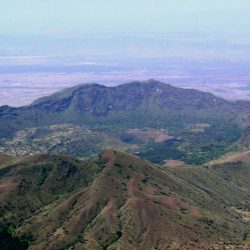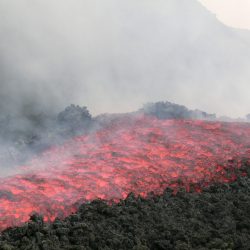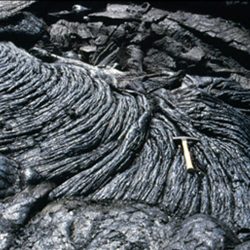Volcanoes and their activity
A volcano is a slit in the earth’s crust through which magma reaches the surface during an eruption.
The eruptive fractures of the volcano Bardarbunga in Iceland

What is magma?
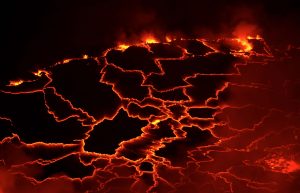
Magma is a natural matter resulting from the fusion of rock material. Magma consists of a liquid phase based on silica (SiO2), a solid phase (crystals and rock fragments) and a gaseous phase (H2O, CO2, hydrogen, sulphur, oxygen compounds and rare elements).
Vesuvius in 1944

Where and why a volcano is formed

The heat of the Earth’s interior is dispersed through the activation of convective cellsthat, in their motion, drag the material thatforms the different layers of which the Earth is composed. The most external layer – the lithosphere (consisting of the crust and the most superficial part of the mantle) – is only partially involved in convective motion and reacts in a fragile way to the resulting stresses, fragmenting into a series of clods that
move drifting.

The planet’s lithosphere is divided into about sixteen plates. Most seismic and volcanic phenomena are concentrated along the edges of the plates, although it is possible that these activities take place within them, at a great distance from the margins that delimit them.
Volcanoes and plate margins
Based on the reciprocal movement between plates, the margins are divided into:
a) Intra-oceanic converging margins
b) Converging ocean/continent margins
c) Divergent oceanic margins
d) Divergent continental margins
In each of these environments volcanoes may be formed.
CONVERGING MARGINS
INTRA-OCEANIC CONTINENT/OCEAN
The Sakurajima volcano in Japan - The Calbuco volcano in Chile
DIVERGING MARGINS
OCEANIC – CONTINENTAL
The mid-Atlantic ridge - The Ertha Ale volcano in Ethiopia
Inside the plates (oceanic or continental) the volcanoes are formed in the areas of hot spots, where there is a rise of so-called “hot plumes” from the mantle.
INTERIOR OF THE PLATES
OCEANIC – CONTINENTAL
The Mauna Loa volcano in Hawaii - The Cameroon volcano in Africa
When the magma reaches the outer surface of the planet there is an eruption.

An eruption can occur through the expulsion of magma in the form of a liquid flowing along the surface. In this case the eruption is called effusive, and its product is a lava flow.
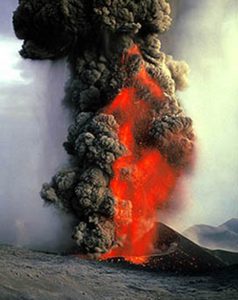
Or, an eruption can occur through the violent expulsion of mixtures of gases and solid or partially molten material. In this case, the eruption is called explosive and will result in the deposition of a wide
variety of pyroclastic products.
Shape of volcanoes
The erupted materials tend to collect around the emission centre, forming volcanic buildings of varying shapes and sizes depending on the eruptive dynamics, the type and quantity of materials emitted, and the duration of volcanic activity.
Shield volcanoes
Mauna Loa (Hawaii) - Meghezez (Ethiopia)
Lava domes
Ischia Castle - Showa Shinzan (Japan)
Stratovolcanoes
Osorno (Cile) - Stromboli (Italia)
Scoria Cones
Scoria cone in Ethiopia - Scoria cones on Etna
Coni e anelli di tufo
Nisida tuff cone (Italy) - Tuff rings (Saudi Arabia)
Calderas
Heavily explosive eruptions, fuelled by huge volumes of magma, can cause the formation of depressed structures in the earth’s surface called calderas, which can occupy areas of hundreds of km2.
Aniakchak (Alaska) - Fantale (Ethiopia)
Maar
As a result of particular explosive eruptions, it can happen that there is almost no accumulation of materials around the eruptive mouth: in this case, not a volcanic building will be formed but simply a crater.
Maar Ukinrek (USA) - Port of Ischia (Italy)
Products of effusive eruptions
In effusive eruptions there is the quiet emission of lava, which flows to the ground reaching greater distances from the eruptive center, depending on the amount of magma erupted in the unit of time, the slope of the substrate and, above all, the viscosity.
Low viscosity lavas will form very fluid castings with smooth or wavy surfaces, with “rope” structures, which are called “pahoehoe”.
As viscosity increases, the levers tend to fragment along the way, forming flows called “aa”, characterized by irregular and scoriaceous surfaces.
In these flows the forehead, during the slow forward movement, becomes progressively more steep, until it collapses, producing large quantities of self-breaking material, which is pushed forward by the body of the flow as if under the pressure of a bulldozer.
Extremely viscous lavas tend not to flow at all, accumulating above the eruptive center and forming squat structures that are called domes or lava domes.
Products of effusive eruptions

In explosive eruptions, the rapid release and decompression of magmatic gases, or the instantaneous vaporization of external water, causes the magma to fragment before it comes
in daylight and expel it in the form of mixtures of gases and solid and liquid particles.

Explosive fragmentation of magma causes the production of solid elements called pyroclasts or pyroclastic fragments. Depending on their size, pyroclastic fragments are divided, from the coarsest to the thinnest, into blocks (or
bombs), lapillus and ashes.
The accumulation of these fragments, through different mechanisms of transport and deposition, determines the formation of pyroclastic deposits, which are divided into fall deposits and pyroclastic flow deposits
Explosive eruptions can be classified according to parameters such as the explosiveness and height of the eruptive column. More violent explosive eruptions will form higher eruptive columns, composed of ever finer particles, which will disperse their products at ever greater distances from the volcano that produced them.



















